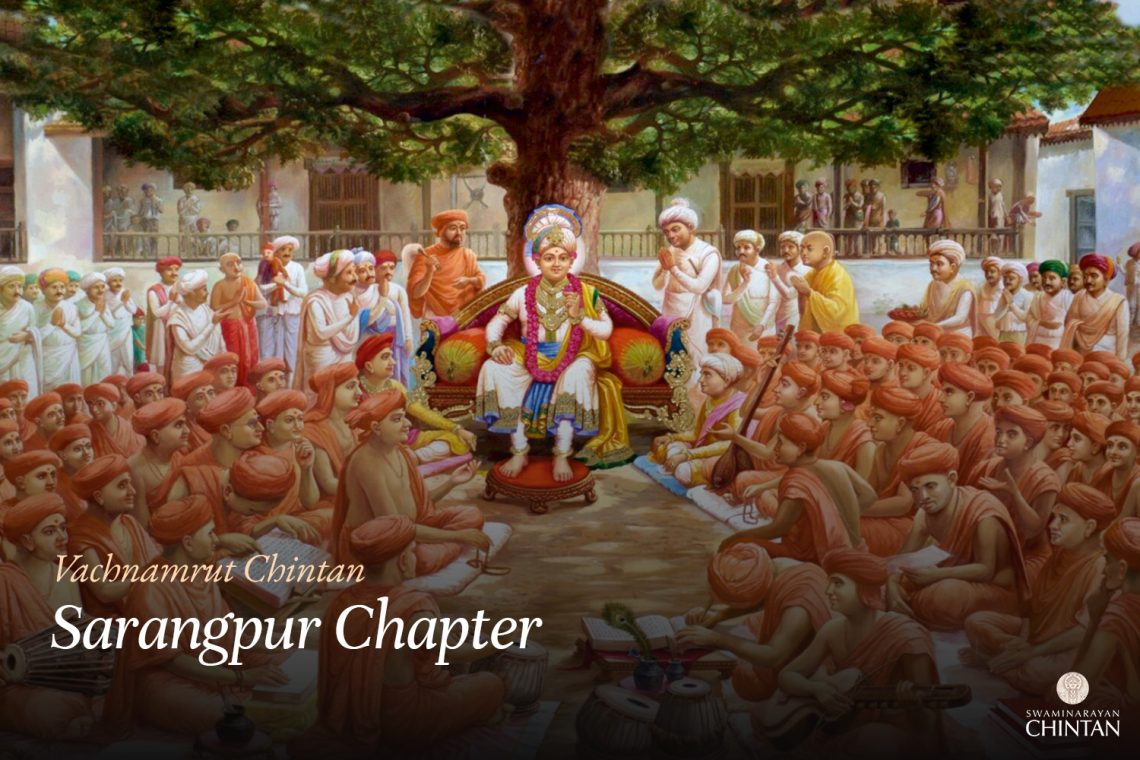Central Insights:
- The highest form of devotion.
Main Points:
- Atmanishtha (firm belief that one is the soul) and Vairagya (detachment) infused devotion is the highest.
- The devotion of the Gopis (devotees of Lord Krishna) is the most superior.
- The Gopis are classified into three categories: Mugdha (innocent), Madhya (moderate), and Proudha (mature)
Commentary:
In this Vachanamrut, Maharaj asked the saints a question. Among the two types of devotees of Bhagwan, one has extreme affection for Bhagwan and cannot remain without His Darshan (divine sight) even for a moment. His love is visibly intense. The other type of devotee also has affection for Bhagwan, but he possesses Atmanishtha and is completely endowed with Vairagya. Although he has love for Bhagwan, his love does not appear as intense as that of the first type. The first type lacks Atmanishtha and Vairagya, yet his devotion shines brightly. Despite having Atmanishtha and Vairagya, the devotion of the second type does not shine as brightly as the first. Among these two types of devotees, whose devotion is superior and whose is inferior? This is the question. Swayamprakashanand Swami responded, saying that even if one lacks Atmanishtha and Vairagya, if he has immense love for Bhagwan, he is superior.
Maharaj then asked, “Why do you consider one who lacks Vairagya and Atmanishtha to be superior? Such a person remains conscious of his body and, when in contact with sense objects that bring pleasure, he becomes attached to them, causing his love for Bhagwan to diminish. How can you call such a person superior?”
From this dialogue between Maharaj and Swami, we can understand that Maharaj wants to draw our attention to the fact that devotion can be categorized from two perspectives: one is devotion that appears beautiful, and the other is devotion that is long-lasting. Which of these is more desirable? The first type of devotion has abundant beauty, attraction, and enthusiasm. The second type of devotion, though less glamorous, is more stable, healthy, and long-lasting, never succumbing to illness. It is this type of devotion that Maharaj prefers. From Swami’s perspective, however, both the means and the end are important. Devotion is the end, and Atmanishtha and Vairagya are the means. The means should not be considered more important than the end. Therefore, even if devotion lacks Atmanishtha and Vairagya, it is still superior to the first type of devotion. Hence, this devotion is the highest. Maharaj’s preference, however, is for devotion that, even though it may lack the outward brilliance of the first type, is still long-lasting and steady.
According to Maharaj, in devotion, longevity is to be preferred over beauty and splendor. This is also the opinion of the scriptures, which describe such devotion as the ultimate. However, many devotees may be attracted to the outward appearance of devotion and, in doing so, may lose its long-lasting essence. Therefore, Maharaj asks, “How can you consider devotion without Atmanishtha and Vairagya to be superior? Such a person is body-conscious. When they come into contact with favorable sense objects, their attachment will grow, and their love for Bhagwan will diminish. How can such a person be considered superior?”
Swami then responded, “We do not consider one who becomes attached to sense objects to be a true lover of God. We consider true lovers of God to be like the Gopis (cowherd damsels devoted to Krishna).”
Maharaj then said, “The Gopis were not as naive as you might think. Their devotion did not lack Vairagya and Atmanishtha. In fact, they were so wise that they surpassed the understanding of those who possess Atmanishtha and Vairagya. This is why the devotion of the Gopis is considered superior even to that of sages like Shuk and Sanak. This has been acknowledged by both the scriptures and Maharaj.”
We may wonder what makes the devotion of the Gopis so special. To understand this, we must delve deeper into the subject. The characteristics of devotion have been described in many ways. In the Narada Bhakti Sutra, Naradji says, “तदर्पित अखिलाचारता, तद्विरहे परम व्याकुलता।।” — tadarpitākhilācāratā tadvismaraṇe paramavyākulatā (Narada Bhakti Sutra) — Total surrender of all actions to God, and extreme anguish in separation from Him. (Narada Bhakti Sutra). This is called Sadhya Bhakti (the goal of devotion), or Premalakshana Bhakti (devotion characterized by love). There are two aspects to this Sadhya Bhakti: total surrender and the pain of separation. Among these, the pain of separation, which arises from the memory of God’s absence, is the essence of Sadhya Bhakti, while surrender is the body of this devotion.
All are devotees—whether Shuk, Sanak, Prahlad, or the Gopis—none lack in surrender, but in the expression of separation, the Gopis are foremost. Therefore, the scriptures praise the devotion of the Gopis above even that of Shuk and Sanak. Such devotion is the pinnacle among all, and it is found in the Gopis. Similarly, Jeevuba, Laduba, Rajba, Premanand Swami, Gopalanand Swami, and Punja Dodia—Maharaj’s contemporary devotees—also possessed such devotion. Therefore, Maharaj says that the devotion of the Gopis did not lack Atmanishtha and Vairagya. It was actually a step beyond that. These devotees were perfect in Atmanishtha, Vairagya, and surrender. Additionally, their inner pain of separation, heartfelt yearning, and deep longing for Maharaj were unique aspects of their devotion. This pain of separation for Bhagwan aroused the highest virtues and wisdom within them. Even Uddhavji, after hearing the words of the Gopis, was moved to tears and desired the dust of their feet.
Maharaj explains that there are three types of Gopis: Mugdha, Madhya, and Proudha. The differences among them are seen in the scriptures based on their words. In all three types of Gopis, there is no deficiency in surrender or the feeling of separation, but their playful interactions with Bhagwan vary, leading to different classifications. The Proudha Gopi does not insist on having her way with Bhagwan and maintains a calm, playful relationship. The Madhya Gopi engages in some playful behavior and has a slight insistence on getting her way. The Mugdha Gopi exhibits both these traits to a greater extent, which is why she is called Mugdha.
Maharaj says that such devotees may engage in sense objects like words, but only if they are related to Bhagwan; they do not entertain thoughts of other sense objects. The state of a devotee lacking Atmanishtha and Vairagya is different. Maharaj explains that just as seeds do not sprout in the absence of rain, but when it rains, the earth is covered with grass, similarly, when such a person encounters unfavorable company, they will become fully engrossed in sense objects and will realize that they have no love for Bhagwan. Therefore, even if a devotee appears to be very loving outwardly, if they lack Atmanishtha and Vairagya, they are very deficient. A devotee who has Atmanishtha and Vairagya and seems to have ordinary affection for Bhagwan, even if they do not appear outwardly eager, has deep roots of love. Their love will not diminish even in the presence of unfavorable company. Hence, such a devotee is superior.
Glossary
| Atmanishtha – Steadfastness in the realization of the soul The firm realization and understanding of the soul’s true nature, living beyond the influence of three kinds of body |
| Vairagya – Detachment From Everything Except God |
| Darshan – Divine vision |
| Gopi – Female devotees of Lord Krishna |
| Mugdha – Innocent or naive Refers to a type of Gopi whose devotional interaction with Krishna is childlike, playful, and emotionally expressive. |
| Madhya – Moderate A type of Gopi who expresses devotion with some playfulness and some restraint; middle category among the three. |
| Proudha – Mature A type of Gopi who is calm and deeply emotionally stable, showing spiritual maturity in her devotion. |
| Sadhya Bhakti – Ultimate devotion The highest form of Bhakti, characterized by complete surrender and pain of separation. |
| Premalakshana Bhakti – Devotion characterized by love A state where a devotee feels intense love and separation from Bhagwan. |
| Tadarpita Akhilacharata – Total surrender of all actions to God A phrase from the Narada Bhakti Sutra signifying full dedication to God in every action and thought. |
| Tad-virahé Param Vyākulatā – Intense anguish in separation from God The deep emotional distress a devotee feels in God’s absence, regarded as the hallmark of highest devotion. |

